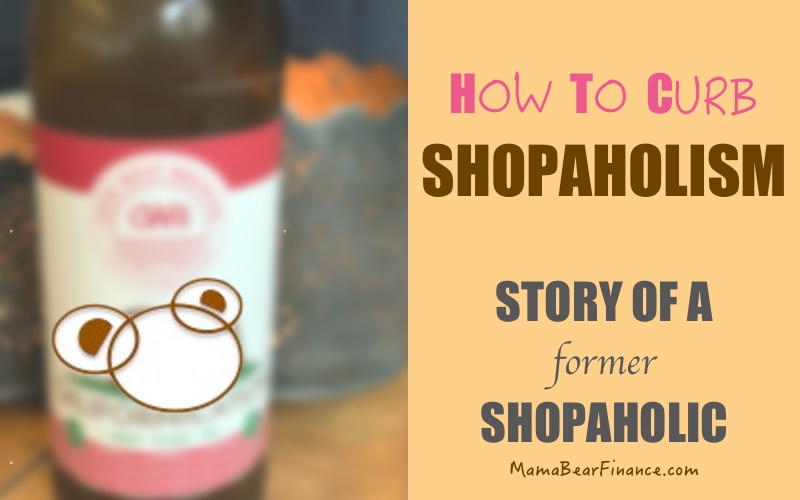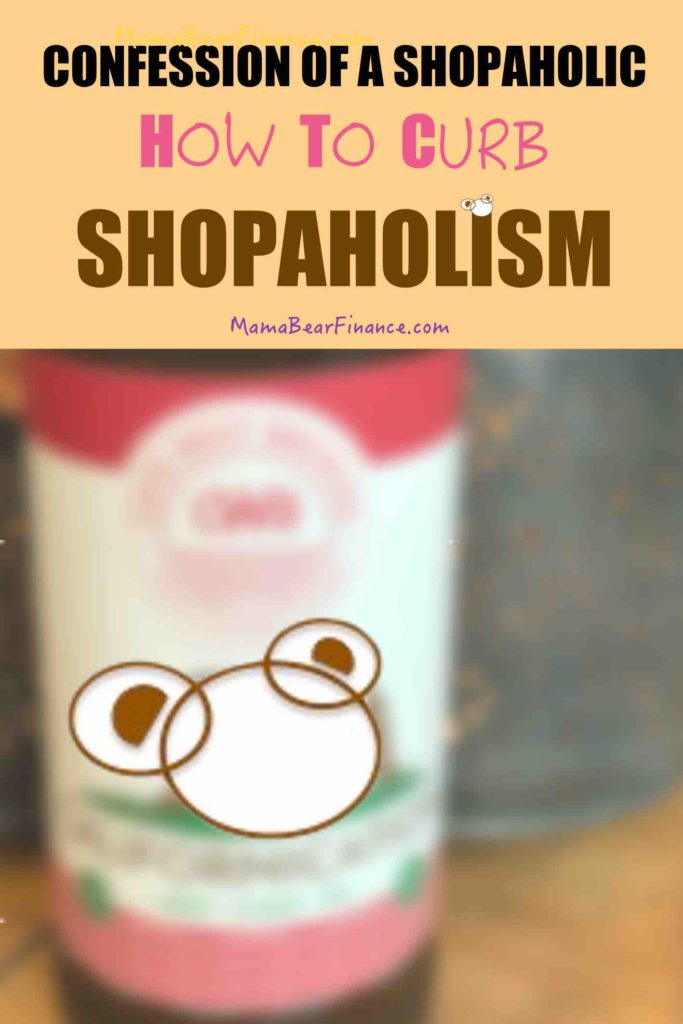Shopaholism is an addiction to shopping. If you suffer from this insufferable habit, let me share with you how creating an inventory list can help.
If you’re not sure whether or not you’re a shopaholic, then here’s a quick checklist of questions that you can ask yourself.
Shopaholism Checklist:
- Do I have a tendency to shop online at least once a day?
- Do I go to the store and end up buying more than I intended?
- Do I have a hard time with saving month after month?
- Do I wish I could save more and spend less but just couldn’t do it?
- Do I make financial goals but have trouble meeting them due to overspending?
If you answered yes to any of the questions above, then I’m afraid you may be suffering from shopaholism.
It’s not hard to be a victim of bad shopping habits especially with the advent of online stores. But while convenience is a great advancement, overspending is not.
Let me walk you through my journey of how I went from being a shopaholic to becoming a mindful consumer.

This post may contain affiliate links, which means I may receive a commission, at no extra cost to you, if you make a purchase through a link. Please see my full disclosure for further information.
The Origin of My Shopaholism Story
Once upon a time, I was a shopaholic.
It was during my tender teenage years when I shopped till I dropped.
Once or twice a week, my mom would bring me to the mall as a teenager. Except for her bank account, my mom doesn’t have any limit especially not when it comes to shopping. She was the complete opposite of my frugal dad, and as a result, they clashed a lot regarding family finances.
Because my mom didn’t have a care in the world, she also loved shopping and often brought me and my sisters to the mall. It wasn’t the best of habits reflecting back now, but it brought some moments of fleeting joy.
And so the story goes like this…
We would go to the mall to buy new clothes chasing after the latest trends, and when these clothes would go out of fashion, we kept going back to buy some more. Again and again!
I ended up having so much clothes in my closet that I didn’t have much space for them and my room became a mess. Since my taste would change year after year (from the 2000s baggy pants to flair jeans to the ‘skinny,’ for instance), I quickly detested the clothes that were no longer in fashion.
But because my parents weren’t rich and I knew how hard they worked to earn that dollar, I had always felt guilty spending it despite my mom’s carefree nature and her insistence on spoiling me.
I guess I do have that frugal genes from my dad after all!
An inventory list was born
But on one bored afternoon, I started to categorize all of the clothes I have and I would make an inventory list of how much they all cost. (Gathering data was already a fun hobby for me back then.)
I did so because I was curious to see how much I’ve spent on the clothes I once loved but later loathed. Once I totaled everything up, I was so shocked on how much I’ve wasted.
Even though I would only buy one or two pieces of clothing every time we went shopping (twice to four times a month), it all added up into thousands – more than $5,000 to be exact!
At that time, $5,000 was a lot of money and to put salt onto the wound, it was a lot of money for 80% of the clothes that I’d no longer like to keep!
I thought to myself, “If only I could convert this $4,000 worth (or 80%) of unwanted clothes into cash so that I can buy newer clothes!”
It then daunted on me that I’ve spent way too much on fast fashion and buying more was not really a smart decision.
A Shopaholic’s Awakening
I started to pay more attention to the new clothes I buy after realizing how small amounts can add up to an unfathomable sum.
This was the first step: acknowledging that there was a problem. And setting up an inventory list was the prescription to that problem. The solution, however, was to change my spending habit.
This happened right around the time I entered college and I read the book, “Affluenza: The All-Consuming Epidemic.” It was about how the ever-ongoing desire for more was the catalyst for the American consumerism culture and a capitalistic machine in full force.

It continues with the psychology into a consumer’s mind whereby we often buy things to impress others while we squander our wealth and happiness. The end result was a stockpile of wasteful goods in exchange for keeping up with the Joneses.
Additional Reading: Affluenza: How Overconsumption Is Killing Us–and How to Fight Back
It related to me right to the core and I had to be honest with myself, I didn’t buy those clothes for me (maybe partially), but I was really buying them to impress my friends and those in my school.
“Those who mind don’t matter and those who matter don’t mind.” – Dr. Seuss
However, the reality was that the friends I had who truly cared about me wouldn’t mind what I wore, and the ones who didn’t care, well, they wouldn’t care at all.
So why do I even try so hard? (I supposed this might happen to my daughter one day so hopefully this post could help her overcome this insecurity.)
Then… I decided to stopped trying hard and instead focus my energy on building inner happiness and wealth.
It was a complete mindset makeover that lifted the weight I had of other people’s judgment and as a result, a reinvention of myself.
Basically, I became a more conscious consumer, a more mindful spender, and a happier person overall.
The Road to Curb Shopaholism
Marie Kondo, who brought to the world the Life Changing Magic of Tidying Up, provided a solution to the big fat mess we made as a result of excessive buying. Her solution was simple: say thanks and then let go.
In many ways, Marie Kondo’s method of tidying up and the notion of keeping only things that sparked joy helped us ease our guilt. That’s because at some point in time, these things were once purposeful.
It also drew attention to that pile of clothes I accumulated in which I didn’t want but have not thrown away, simply because I paid too much for them.
Marie Kondo helped us re-evaluate the things we have and eventually appreciate the ones we keep. That’s a good starting point, but what happens next?
What happens after tidying up?
For some people, they will become a minimalist where they will continue living with less and become more conscious of what they buy next. This is great not only for their pocket but for the environment as well.
However there remains those who, after cleaning up, would slowly (and unconsciously) get back into the groove of buying more.
You know what they say, “Old habits die hard.” So, their spending habit will once again resurface and their house flooded with new stuff.
For this subset of people, who despite their conscious effort to KonMari their life, I suggest doing the following: create an inventory list.
Doing so would put into perspective of how much has been spent on the things they absolutely love (or “sparked joy”) and those they wish they could go back in time and undo that credit card swipe!
How to Set Up an Inventory List
Creating said list is a simple yet arduous task, one that would break a nerve if you’re not into finding out the truth or if you have an oversized closet.
But if you’re up for the task, then you may find my method to curb bad spending habits helpful.
Step-by-step instructions:
- Make a list of all the items you tend to over-accumulate. Separate the list into two categories: the ones that “spark joy” and those that don’t
- Try your best to guesstimate how much you spent for each of the item (e.g. clothing) at its original retail price
- Tally up the total (then feel free to yell, “What was I thinking?!”)
- Subtotal the items you love and set this list aside (refer back to this list anytime you’re about to make a new purchase and ask, “Is this worthy of joining the joy club?”)
- Subtotal the items you no longer love. Take a deep breath and try to think about what you could have done with all that money, then forgive yourself.
Shopaholism for Cute Baby Stuff
As parents, we want to buy the best for our baby. But somewhere in that secret compartment of consciousness, we also want to dress our baby to our taste.
For example, buying a matching mommy and baby outfit or that classic black Ergobaby to go with your outfits.
Why, of course, our baby is an extension of ourselves, so why wouldn’t we want to splurge a little bit?
This is exactly what resulted in the boom of a multi-billion-dollar baby industry. Oh parenthood!
But unlike buying clothes for ourselves, which could last for years, buying excessive new clothes for babies is like throwing money down the drain.
Babies grow at an incredibly rapid speed that by the time a new season rolls by, their old clothes literally become “so last season.” So why fill up that closet with tons and tons of baby clothes only to be worn a fleeting moment of time?
Related: Why You Shouldn’t Overspend on Baby Items
Keeping an inventory list and expense tracking
What really helped us in minimizing our splurges on baby items were to create an inventory list and track expenses.
By doing so, it really puts into perspective of what we spent so far.
This really helped curb our urges to buy and accumulate more despite how cute baby items looked on the shelf and online.
You can review a breakdown of our spending and inventory list for our baby here:
- First six months: $2,267
- 7th month: $308
- 8th month: $277
- 9th month: $187
- 10th month: $242
- 11th month: $482
- 12th month: $254
- Total One Year Spending: $4,017
Shopaholism: An Afterthought
And so before you get rid of those clothes, shoes and baby stuff, take a moment to say thanks and put them in an inventory list.
After you KonMari your house and wardrobe, use that inventory list to remind yourself of all those money you tossed away. (I’m just being a bit melancholy to balance Marie Kondo’s infectiously happy persona.)
If you’re a parent, try creating an inventory list and use it as a guide the next time you contemplate on buying something new.
Once a list is created, it will just snowball into a much bigger list because you will undoubtedly buy more baby items. (Such is the nature of raising a child.)
But if you’re diligent in maintaining this list, you will soon realize of how much you already have. By doing so, hopefully, it will stop you from overspending.
Yes, some items may have served you well at some point in time (and so you say your thanks), but let the inventory list be a constant reminder (and motivator) to not squander away any more hard-earned cash. Surely, you must have a better use for that money?

Whenever you cleaned up your wardrobe, how did you feel about getting rid of all those clothes? Do you think setting up an inventory list would be helpful to become a more mindful spender? What are your thoughts about what to do after you’ve “KonMari” your closet?
PIN till you drop



If I lived with my mom growing up, I have a feeling I would have had a similar story. Every time she did come to get me which wasn’t very often, the first place she took me was the mall. However, because I was raised by my dad and very frugal, laid back stepmom, this never became a habit for me. I love this idea of creating an inventory list though for people who have this problem. It’s easier than ever to shop and have something to your house in less than a day. Crazy!
Feels like the post was written for me! I am a toxic shopaholic but more for household stuff rather than personal belongings! But the point is that I always buying more than I need and then they go out of date!! Surely Learnt something! Thanks
Haha, glad you can relate to this! I can see how one can overspend on household stuff too. It’s fun to decorate your space!
Thanks for your kind feedback!
I can definitely relate to spending on cute baby stuff. And when I had a little girl after two boys, I couldn’t resist buying all the pretty girly stuff! Thanks for all your great tips in this post that are really enlightening!
Haha.. girl stuff are the hardest to overlook cause they are so cute!! The selection is just amazing these days. But in the end, we don’t need most of what’s out there.
Cute baby stuff is my weakness or really anything for my kids. I definitely should curb my spending habits on things for them! These are some really great tips. Working on inventorying my kids clothes for sure.
I completely understand that weakness. From time to time, I have that too whenever I go shopping for something I need but then ended up wanting to buy something that I don’t… baby stuffs are very tempting…
I didn’t realize I had this problem but I guess I do. I spend money on little things here and there but it all adds up at the end of the month. Thanks for this article.
You’re welcome! I read somewhere that all it takes to spend $10,000 frivolously in one year is by spending just $27.39 a day.
I’m afraid to even attempt categorizing and assessing how much I’ve spent on clothes because I already know the answer. I spent too much on fast fashion, but thankfully, I have been curbing those wayward mistakes and have made a full recovery.
Haha, yes it could sound daunting. I did this exercise in my teenage years and ever since then I would only do some mental calculations from time to time. The answer is always shocking but it does stop me from wanting to buy more.
I have to admit that I can be quite excessive about my spending habits. However, if I know I may want to splurge or indulge with shopping, I always make sure the important stuff like bills are taken care of first ♥️
Yes, bills should come first before any fun splurging activities. It’s very easy to go overboard nowadays especially with online shopping.
I know so many people that struggle with this! I’m pinning and sharing this! Great post!
Thank you!
I used to be a shopaholic as well. Practicing minimalism and contentment and doing no-spend challenges helped me curb those habits. I’m so happy to be reformed.
So glad to hear about that! We are trying to be minimalists as well. It’s not always easy but it’s worth a try cause it feels great to have less clutter.
I really need to do this! Thank you for sharing. Will work on inventory this week.
Yes! That’s great to hear. Good luck with the inventory list and don’t give up 🙂